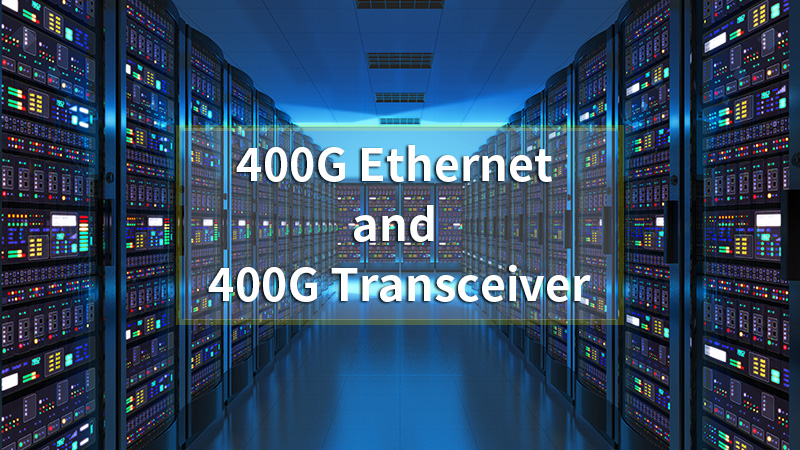What is 400G Ethernet and 400G Transceiver?

The explosive bandwidth requirements in the Ethernet interconnection field require higher interface speed. 400G Ethernet will be the right speed choice in the next step. This article will explain what is 400G, why 400G is important, and 400G Ethernet standards. Also, the article will introduce the common 400G transceiver types, to help you get a better understanding of 400G optics.
What is 400G?
400G, as its name implies, provides 4 times the max data transfer speed than 100G. Ethernet has deeply connected with our life after more than 30 years of development. Not limited to data centers and enterprise LANs, Ethernet is essential in many areas such as our home network, campus, health care, and so on. The speed of Ethernet has been continually increasing: 10M, 100M, 1G, 10G, 40G, and 100G. Ethernet's speed growth rate is approximately 10 times improving every 10 years. Today, 100GbE (100 Gigabit Ethernet) technology Ethernet has been achieved and deployed on a large scale. However, to meet the fast-growing demands of network bandwidth, Ethernet must develop at a higher speed. So here comes 400G.
400G is seen as the next frontier for cloud networking. 400GbE (400 Gigabit Ethernet) can further improve the network load capacity and data transmission rate on the basis of 100G Ethernet while reducing the network transmission cost. Mobile Internet, cloud computing, HDTV video-on-demand, etc. are all challenging the carrying capacity of the network. 400Gbps Ethernet will first be applicated in the interconnection between large metropolitan area networks and large data centers, and then gradually expand to wide area networks and civil applications. 400Gbps Ethernet can meet the needs of various new application scenarios, and its future prospects are worthy of the industry's expectations. It will be a trend in the development of the next-generation Ethernet.
400G Ethernet standard
In December 2017, the IEEE 802.3 Ethernet Working Group formally approved the new Ethernet standard IEEE 802.3bs. It includes the media access control parameters, physical layer parameters, and other main management parameters required by 200GbE and 400GbE.IEEE 802.3bs standard marks the 400G Ethernet start of commercial deployment and application.
What’s driving 400G network forward?
What's driving the 400G network? 400G network is driven by many network applications, including 4K HD videos, VR/AR technology, autonomous driving, telemedicine, robotic surgery, etc. All of these applications can't do without storage, computing, and network connectivity.
There are two vital metrics for network connectivity: bandwidth and delay. Different applications have different index requirements. For delay, AR and VR should be less than 7 milliseconds, and robotic surgery should be less than 5 milliseconds, which means the network infrastructure needs to get greatly improved. As for bandwidth, take robotic surgery for example, it requires more than 1G of continuous and reliable bandwidth, which is a huge challenge to the current network infrastructure. And also, the traffic of video is growing rapidly. When classifying the entire Internet traffic, it is estimated that more than 80% of the traffic comes from video. Nearly all types of Internet applications are moving towards the form of video, such as Tiktok. So video is a very important medium for future interaction, especially for real-time video streaming, such as multi-party video conferences.
Of course, the driving force of the 400G application also includes 5G. From a macro perspective, you only need to remember three things about 5G: bandwidth, the number of users accessed, and delay. To be specific, firstly, for bandwidth, the vision of 5G is that the download rate of the air interface should reach 20G, and the upload rate should maintain 10G. Secondly, the delay is required to be less than one millisecond. And thirdly, 5G should be capable of 1 million connection objects per square kilometer. These three together form a 5G network. This is just the nervous system of the future society, so what is the social brain? It refers to various forms of data centers. All traffic will enter various data centers for calculation and storage.
400G QSFP-DD Transceiver Overview
When it comes to the development of 400G, 400G optical modules are indispensable. There are various kinds of 400G optical modules at present. QSFP-DD is the highest density of 400G transceiver form factors today. This part will briefly introduce the common 400G QSFP-DD transceiver types.
400G QSFP-DD SR8 Transceiver
400GBASE-SR8 module supports 400 Gigabit Ethernet rate over eight-lane parallel multimode fiber (MMF). SR8 uses an MTP/MPO-16 connector with link lengths up to 100 meters.
400G QSFP-DD DR4 Transceiver
400GBASE-DR4 module supports 400Gb/s over four-lane parallel single-mode fiber (SMF). DR4 uses an MTP/MPO-12 connector and the max transmission distance reaches up to 500 meters.
400G QSFP-DD FR4 Transceiver
400GBASE-FR4 module supports 400Gb Ethernet link over SMF. FR4 uses an LC connector with link lengths up to 2km.
400G QSFP-DD LR4 Transceiver
400GBASE-LR4 module support high-bandwidth 400G links over four wavelengths of CWDM signals. LR4 enables long-haul distances up to 10km over SMF with a duplex LC connector.
400G QSFP-DD FR8 Transceiver
400GBASE-FR8 module supports 400G Ethernet link over an eight-wavelength WDM signal. FR8 enables transmission distances up to 2km over single-mode fiber (SMF).
400G QSFP-DD LR8 Transceiver
Similar to FR8, the 400GBASE-LR8 module also supports a 400G Ethernet link over an eight-wavelength WDM signal, but SR8 is suitable for long-range transmission with extended link lengths up to 10km over single-mode fiber (SMF).
Explore the QSFPTEK 400G Portfolio
QSFPTEK privodes a wide variety of high-bandwidth 400G optics 400G optical transcievers and cables for data centers. The specifications of 400G portfolio is listed as below:
For more information about 400G optical modules and cables, please feel free to contact QSFPTEK team via [email protected].










